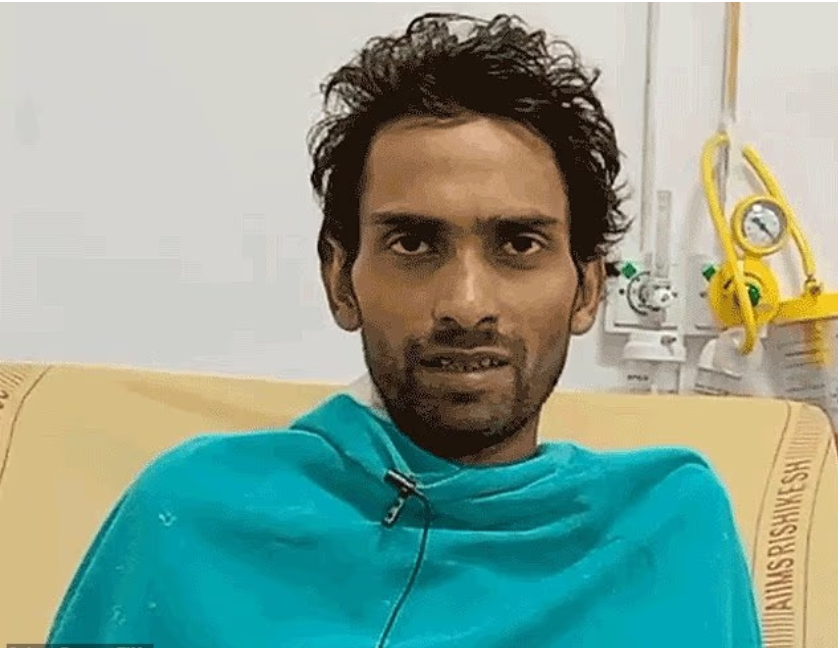A Medical Milestone in Modern Surgery
When doctors in India removed a 76.5-pound tumor from a man’s leg in June 2025, they didn’t just complete a high-risk operation—they rewrote what’s possible in orthopedic oncology. The tumor, weighing as much as a young child and spanning four by two feet, had grown uncontrollably inside 27-year-old Mohd Salman, a former laborer. For years, it silently expanded in his leg without causing pain—until it didn’t.
In just six months, the slow-growing cancer suddenly accelerated, rendering him immobile, bedridden, and in constant agony. With little hope and multiple failed consultations, Salman finally found a lifeline: Dr. Mohit Dhingra and his team at AIMS Rishikesh Hospital.

Understanding Chondrosarcoma: The Cancer That Crept In
Salman’s tumor wasn’t just large—it was the product of a rare cancer known as chondrosarcoma, which develops in the cartilage, the protective tissue around bones. Unlike many aggressive cancers, chondrosarcoma often grows slowly. That’s what makes it so deceiving. For years, patients can live symptom-free until the tumor reaches a size that compromises mobility, comfort, or even survival.
While most commonly found in the hips, pelvis, or shoulders, it can develop elsewhere—in Salman’s case, his leg. Over time, the tumor ballooned to a shocking weight of 76.5 pounds—roughly equivalent to an eight-year-old child. Not only did it leave him unable to walk, but it also pushed his body to the edge of collapse.
Video : 5 Alarming Signs of Bone Cancer
A Tumor Too Big to Ignore
By the time Salman reached Dr. Dhingra, the situation was desperate. His leg could no longer support him. He was confined to bed, experiencing intense physical and emotional distress. Local doctors had refused to operate, citing the size and complexity of the tumor.
That’s when the team at AIIMS Rishikesh took on the challenge. Dr. Dhingra described it as one of the most demanding operations of his career. “The sheer weight and complexity of the tumor pushed our team to the edge of medical precision,” he explained. But the mission was clear: give Salman his life back.
The Six-Hour Surgical Battle
Before making the first incision, the surgical team needed to map out every artery and vein. That meant a full-body MRI and angiography—procedures designed to visualize blood flow and avoid catastrophic bleeding during surgery. One wrong move, and Salman could lose not only his leg—but his life.
On June 9, 2025, after weeks of preparation, the operation began. It took six hours, surgical skill, and a united team effort to successfully extract the massive tumor without complications.
No ruptured vessels. No blood loss disasters. Just clean, calculated, careful execution. By the end of it, Salman’s leg—and his life—were saved.
A Rare Surgery That Turned Heads
In the medical world, operations of this scale are extremely rare. According to AIIMS-Rishikesh executive director Meenu Singh, this surgery represents a “landmark moment” in cancer care—especially for hospitals handling rare, neglected cases. It’s not every day a team pulls off something so complex, so dangerous, and so technically intense.

For comparison: the largest tumor ever recorded was a 328-pound ovarian tumor removed in 1906. More recently, in 2022, Brazilian doctors extracted a 100-pound mass from a woman’s abdomen. While Salman’s case wasn’t the biggest, it stands among the most difficult in modern times due to its location, blood supply, and life-threatening risk.
The Road to Recovery Isn’t Over
Though the surgery was a success, Salman’s journey is far from finished. More than three weeks later, he’s still in the hospital, undergoing post-operative monitoring and preparing for rehabilitation.
Doctors believe he may require physical therapy to relearn how to walk, strengthen his muscles, and regain balance. Being bedridden for months takes a toll on the body, and his recovery will likely take time and patience. But compared to where he started? He’s already won half the battle.
What Makes Chondrosarcoma So Dangerous
Unlike other cancers that respond well to chemotherapy or radiation, chondrosarcoma is notoriously resistant to both. That means surgery is the gold standard—and often the only viable treatment.
The cancer accounts for around 25% of all bone cancer cases in the U.S., totaling roughly 1,300 cases a year. Although it progresses slowly, it still kills about one in five patients within five years. Its silent nature makes early detection difficult, and once symptoms appear, the tumor is often already advanced.
In Salman’s case, it’s still uncertain whether his cancer has spread to other parts of the body. If it has, his treatment may require additional intervention. But for now, the most immediate threat—the giant mass consuming his leg—is gone.
Video : This Man’s Massive Tumor has been Removed😲
When Medicine Meets Miracles
It’s easy to take modern surgery for granted. But in cases like this, where everything is on the line, it becomes clear just how remarkable skilled medical teams can be. This wasn’t a typical operation. It was an extreme case with extreme risk—and it ended with a success story that’s still sending ripples through the medical community.
Salman’s words say it best: “The doctors didn’t just remove a tumor—they gave me my life back.”
Conclusion: More Than a Tumor, It Was a Turning Point
What began as a small, slow-growing lump ended in a life-altering procedure that tested the limits of surgical medicine. Mohd Salman’s case is a reminder of what happens when bravery, expertise, and compassion come together in the operating room.
The story doesn’t end with the tumor’s removal. It continues through every step Salman takes in recovery—and with every life this case might inspire doctors to save in the future.
This wasn’t just about one man. It was about redefining what’s possible in medicine. And for anyone facing the impossible, that’s exactly the kind of hope the world needs.


